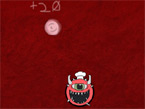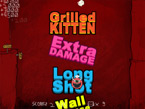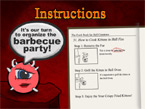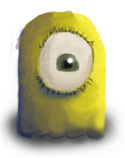Postmortem: Pluto Strikes Back
December 9th, 2006A little bit over month ago I released my third experimental done-in-under-7-days game: Pluto Strikes Back. The game has gotten a very good response from players and it’s a game that even I still enjoy playing. Here are some of things I learned from the development of the game.
What Went Right
1. Toy First
Building the toy first turned out to be a very good idea. I created a very ugly physics toy, where I had some planets (blue circles), the bat (blue square) and I could launch asteroids (smaller blue circles) by a click of the mouse. And I used this toy to prove myself that the core mechanics where fun enough to build a game around.
I then spend almost half of the development time lubricating this ugly bugger so that it was even more smooth to play with. And toy turned out to be surprisingly fun to play with, unlike the toy that I created for Slimy Pete’s Singles Bar.
I then wrote down all the things that felt satisfactory to me in the toy. Like hitting a planet really hard so that collided with the other planets or managing to strike an asteroid so that ended up orbiting a planet. Then when I started working on the graphically intensive version of the game I made sure that the player would be awarded when he managed to perform these activities. The awards where in the form of sound effects, scores, animations and bonuses.
2. Juiciness
The game feels quite juicy. Credit for this goes to the fact that I did spend quite some time working on the basic strike an asteroid hit a planet sequence. I wanted it to feel very juicy. So I created a very simple spring system to pull the planets back to their original positions. This really did boost up the game and I think it’s the most important part of the juiciness factor.
Here’s a list of things I added to make the hitting of a planet feel really extra juicy.
Elements of juiciness in Pluto Strikes Back
- The already credited spring system
- The Candid Camera sound effects (when you hit a planet it sounds like it)
- Rising score message
- Running score counter
- The big bonuses that you get almost every time you strike an planet
Also the background song, which I encountered by pure accident, brings it unique flavor of spinning goodness to the game.
3. Let my baby take it’s course
The first two games that I did, I really prototyped the original idea that I had in my head. I didn’t want to change it or tweak it on the way, because basically I was creating a prototype of that idea. It felt like I would cheat if I changed my mind during the development. Pluto Strikes Back was different. It was much more like a series of prototypes than a one big one.
In terms of gameplay there was very little progress. The original gameplay idea turned out to be very fun so I kept it pretty much intact. Although all the bonuses where developed during the prototyping.
The story did change a little. As the original idea was from a weird dream I had. The player would defend Earth against an asteroid attack by swinging a baseball bat. But that really lacked a reason to try to aim the asteroids to something. Then I figured that maybe Pluto should play the main part, because of the all media coverage. That then quite easily turned into a game that was only about Pluto getting it’s revenge.
I think it’s good to let go of the original idea and let the development take it where ever it is going with it. Clinging too much to the original idea can really kill a good game.
Things That Went Avery
1. No real play testing
Unfortunately I couldn’t afford to use a industry leading QA department to test out my game. I mainly balanced the gameplay based on my own experiences. I should have used couple of friends as testers. In the past I have learned a lot from watching other people play my games.
The biggest problem was the too high gravity of Pluto, that caused some of the new players to get frustrated trying to get the asteroids out of Pluto’s gravity field. I didn’t realize that this was a problem until people started reporting about it at various game development forums. I then dragged a friend who had not played the game to my house and watched how he played. And that’s when I realized that maybe the Pluto’s gravity field was a bit too heavy.
After that I released a quick patch that fixed some random bugs, made the bat controls a bit more firm and eased on the Pluto’s gravity. The new players praised the new patch, but the hardcore players felt that it made the game too easy. Well, you cannot please everybody.
2. Bugs
There where some nasty bugs left in the game. The cause of this basically the same as the last items: no real play testing. The bugs where of that kind that the player would get unrealisticly big scores. Luckily it was quite easy to fix, but unfortunately it really twisted the comparing of the scores.
3. I ran out of time
With Pluto Strikes Back I really did run out of time. Luckily I managed to implement all the important features for the gameplay that I wanted (not including the destruction of planets). But some of the small things that I would have liked the game to have, I could not do in the 7 day limit.
Conclusion
Pluto Strikes Back was a prototype to prove that the core mechanics could work and where fun to play. Right now I don’t know what future holds for Pluto, but I would definitely like to continue the development of the game. Hopefully I have time to release a new version of the game that would include the much needed and desired highscore list.
Btw. Big thanks to everybody who downloaded and played the game. And even bigger thanks to all of you who took the time to write comments and suggestions about the game. The comments really motivated me (and still do) to work on the game further from it’s initial release.



 There’s a new version of the game (Release 1.5). It fixes the “endless” score bug and makes the game a bit easier to gasp. It also makes a lot of the content modable. The new version can be download from
There’s a new version of the game (Release 1.5). It fixes the “endless” score bug and makes the game a bit easier to gasp. It also makes a lot of the content modable. The new version can be download from